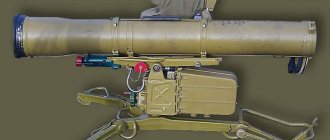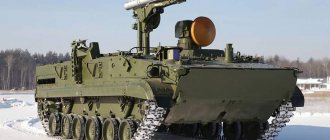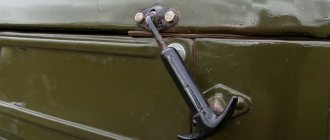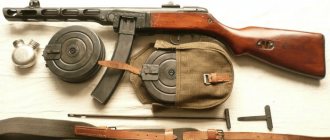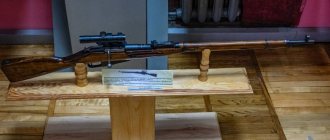Until recently, the Kornet ATGM, operating on the “See and Shoot” principle, was considered an innovative development of Soviet scientists, which many armies around the world wanted to receive. Now, the situation has changed dramatically and the Armed Forces are expecting a new project capable of firing missiles under the slogan: “Fire and forget.”
At first glance, there is practically no difference, but upon closer analysis of the two phrases, many distinctive characteristics appear, primarily related to preserving the life of combat crews.
History of creation
The first development of anti-tank missile systems began in the middle of the Great Patriotic War. Towards the end, German engineers were able to assemble several hundred Rotkappchen ("Little Red Riding Hood") ATGMs. After the victory, the Allies received test samples, which later became prototypes for their own developments.
Domestic scientists began similar actions only a few years later, in the early 50s. At the same time, the first development of Soviet specialists, “Malyutka,” was recognized as a world bestseller; the effectiveness of its use was not associated with a relatively simple design.
Within a few weeks of use in the Arab-Israeli war, it was used to destroy more than 800 enemy armored vehicles.
Over the years, the design and tactical and technical characteristics of anti-tank missile systems have been improved, as a result of which the problem of the first generation associated with the need to control the missile throughout its flight has disappeared.
The installations receive a semi-automatic target guidance system and increased speed. These modifications are still actively used in many armies of the world, while the Russian Armed Forces have switched to elements belonging to the third generation, called “Cornet”.
Work on a new modification, which later received the designation ATGM "Kornet", began at a difficult time for the country, at the end of 1988. Engineers of the Tula Design Bureau honorably completed the task assigned to them and in mid-1994 the first samples of the complexes began to arrive at weapons of the Armed Forces.
It should be emphasized that at the time of the official presentation taking place in Nizhny Novgorod, the weapon blew up the entire military-political society on both sides of the ocean.
The new product was in many ways superior to modern models, and one could learn how to work with it within one day. This characteristic served for the subsequent production of complexes for sale abroad (“Cornet” EM, “Cornet” E).
Interesting! For your information, in the use of early models of the first and second generations, the hit accuracy was 95% dependent on the operator’s professionalism and composure.
Device
The Kornet ATGM is equipped with a control system identical to those used in aircraft production. The installation received a powerful laser projector that illuminates the target.
As a result, the reflected element is detected by the photodetector, and the homing system processes the received information and corrects the flight course. If we analyze the comparative characteristics of the second generation, we can highlight a number of innovations related to the new complex:
- In order to aim and reach the target with the missile, the operator had to manually control its flight. A joystick was used for this. The disadvantage of the method is that when the enemy returned fire, the slightest inaccurate movement of the finger led to the fact that the fired projectile flew past the target. The modern installation has a completely different type of targeting;
- It is now impossible for the wire to be broken by flying fragments or bullets - everything is hidden under a bulletproof casing. The new Kornet ATGM can operate autonomously and is equipped with “smart” missiles that independently correct their course.
The entire structure of the complex can be divided into 2 parts:
- Launcher (portable or stationary);
- A guided missile, characterized by different flight ranges and different warheads.
The portable (universal) version is the 9P163M-1 launcher:
- Tripod;
- Sight guidance device 1P45M-1;
- Trigger mechanism.
At the same time, the installation height is adjustable, which makes it possible to fire from different positions (sitting, standing, lying down).
It is allowed to install a thermal imaging sight consisting of an optical-electronic unit, control elements and a cooling system. The weight of the installation, excluding the rocket, in this case will be only 25 kg, which allows it to be installed on any mobile carrier.
Performance characteristics
Due to the fact that several modifications of the complexes were developed, the performance characteristics of the gun modifications differ slightly:
- “Cornet” E – export model of a standard gun;
- “Cornet” D - a modernized installation with an increased missile flight range and the ability to penetrate 13 cm thick armor;
- “Cornet” EM – export modification of the version with the index “D”;
- "Cornet" T is a self-propelled armored vehicle based on the BMP 3.
The table below shows the tactical and technical characteristics of both standard modifications and more advanced Kornet D and Kornet EM complexes.
| Characteristic | Magnitude | Note |
| Rocket flight range, km. | During the day – 5.5 At night – 3.5 | For “Cornet” EM and “D” up to 10 |
| Minimum range, m | 100 | — |
| Caliber, mm. | 152 | — |
| Rocket length, mm. | 1200 | — |
| Rocket speed, m/sec. | 350 — 400 | — |
| Armor-piercing, mm. | Metal armor – 1,200. Concrete monolith – 3,000 | For models “Cornet” EM and “D” the value reaches 1,300 |
| Target recognition range, m | 2 500 | — |
| Readiness to fire after detection, sec. | 1-2 | — |
| Rate of fire, shot/min. | 2-3 | — |
Interesting! An interesting fact is that the “Cornet” E and “Cornet” EM variants, developed for other armies, are intended for use in temperature ranges from -20⁰С to +60⁰С, and the complexes assembled for domestic aircraft are from -50⁰С to +50⁰С.
Notes
- , With. 174.
- , With. 173.
- ↑ (inaccessible link). Retrieved August 25, 2011.
- ↑. Of. website of the Instrument Design Bureau (2010). Retrieved April 20, 2013.
- ↑. Website militaryrussia.ru
. Retrieved October 15, 2011. - . Retrieved September 22, 2016.
- . www.kbptula.ru. Retrieved September 22, 2016.
- ↑
- The Military Balance 2013. - P. 370.
- The Military Balance 2013. - P. 141.
- The Military Balance 2007. - P. 181.
- The Military Balance 2013. - P. 386.
- ↑
- The Military Balance 2013. - P. 503.
- The Military Balance 2013. - P. 466.
- The Military Balance 2013. - P. 404.
- The Military Balance 2013. - P. 183.
- The Military Balance 2009. - P. 200.
- (English). southfront.org (03.10.2017). Retrieved January 26, 2018.
- ↑. NEWSru.co.il (January 28, 2015).
- ↑
- ↑ The Military Balance 2007. - P. 211.
- (English). terrorism-info.org.il (11/11/2012).
- ↑
- Yulia Troitskaya.
. RIA Novosti (17:15 16/08/2006). Retrieved May 6, 2009. - ↑
- Khlustov Mikhail Vladimirovich. Southern Lebanon // Use of tanks at the end of the 20th and beginning of the 21st centuries. Analytical report. - M.: ANO "TsSOiP" // Magazine "Samizdat", 2013.
- Jeremy Binnie.
(English). IHS Jane's Defense Weekly (20 June 2014). - . www.militaryparitet.com (June 20, 2014).
- . וואלה! חדשות. Retrieved November 13, 2014.
- . NEWSru.co.il (May 5, 2019).
Combat use
Although the Kornet ATGM was put into service in the mid-90s, it underwent its first baptism of fire only in 2006 in Lebanon. With its help, the terrorist group Hezbollah partially thwarted the offensive of the Israeli army.
According to official sources, 46 Merkava tanks were knocked out. It should be noted that not all of them were destroyed or damaged by Russian-made ATGMs. After some time, it became known that the terrorists received the complexes through the Syrian border.
Interesting! The Islamists themselves claim that the losses of the Israeli armed forces were much greater.
In addition to this, there are many more examples of the use of the Kornet ATGM:
- Throughout the entire period of the civil war in Syria, the looted arsenals of the Government Army passed into the hands of the opposition and the ISIS group. As a result, the complexes are actively used in military clashes by both sides;
- In 2011, the Hezbollah group fired a Kornet EM at a bus carrying Israeli schoolchildren;
- Many battles in opposition to the United States and Iraq often ended in the destruction of American armored vehicles. The Asian army was armed with Russian anti-tank systems.
Despite the fact that during the First and Second Chechen Wars the Kornet was already in service with the Russian Armed Forces, it was not used there. The Russian military used Bassoons.
Operating countries[edit]
As of August 2009, 35,000 units of the Kornet ATGM were sold:
- Armenia - according to the Center for Analysis of the World Arms Trade, Armenia purchased 50 anti-tank systems and 200 missiles for it in 2013.
- Russia - about 750 Kornet ATGMs, as of 2009.
- Algeria - 64 BRDM-2M and 304 BMP-2M with Kornet-E launchers, as well as a number of portable launchers, as of 2013. About 3,000 9M133 units were supplied from Russia between 2006 and 2010.
- Greece - 196 PU 9P196 “Kornet-E” in service with the Ground Forces, as of 2013. The delivery was carried out in two stages, under a contract concluded with Rosoboronexport in 2001 for 278 ATGMs.
- India - more than 250 9P196 Kornet-E launchers and about 3000 9M133 units were supplied from Russia between 2003 and 2006.
- Jordan - 200 launchers and 2000 9M133 units, as of 2013. Delivered from Russia between 2009 and 2010.
- Cote d'Ivoire - a number of Kornet-E ATGMs, as of 2013.
- Libya - quantity and status unknown.
- Peru - 22 M1165A2 with Kornet-E launchers and 244 ATGMs, as of 2013. The contract was concluded in 2008 for the amount of $23 million.
- Syria - 1000 ATGMs and 100 Kornet-E launchers, as of 2013. The supply contract was completed in the 90s for the amount of 65 million dollars.
- Turkey - 80 Kornet-E launchers, as of 2013, including up to 800 missiles delivered in 2009 under a contract concluded with Rosoboronexport in 2008.
- Eritrea - 80 9M133 units were delivered from Russia in 2005, the total contract amount is $170 thousand.
Paramilitary organizationsedit
- Hezbollah - it was reported that this organization has the Kornet-E ATGM. During the Second Lebanon War, Hezbollah militants used Cornets to fight Israeli armored vehicles.
- Hamas
- Islamic State of Iraq and the Levant - in May 2015, ISIS published video footage of Kornet-E systems captured in Iraq, produced and delivered to the Iraqi army in 2014. The exact number of captured complexes is unknown.
- Ansar Allah - the Kornet-E ATGM was used when firing at Saudi troops.
Prospects for improvement
Not long ago, the Chief of the Missile Forces and Artillery of the Russian Armed Forces, Lieutenant General Mikhail Matveevsky, emphasized that work on the creation of the latest generation anti-tank missile system is already underway. The installation will meet all modern standards and operate on the “fire and forget” principle. The main task, in this case, is to replace the Kornet ATGM.
Despite the fact that the domestic military considers our complex to be the third generation, world observers do not agree with them. Imported developments belonging to this class already comply with this principle, “Cornet” does not yet. That is, immediately after the shot you can change your position, rather than wait for a return bullet or shell.
In our case, although it is necessary to wait for the result, since the system monitors the flight of the rocket, making the necessary adjustments. Let it do this in automatic mode, but until the projectile reaches the target, you cannot touch it.
In addition to this, the Kornet ATGM complex, Kornet EM and all other modifications have several more disadvantages:
- The total weight of a loaded unit, ready to fire, is almost 50 kg;
- Aiming at a target using a laser beam results in the position being unmasked;
- Currently, most countries have adopted active protection systems for armored vehicles designed to combat laser beam guidance. The easiest way is to create a polarized smoke cloud by irradiating the tank with a search beam;
- The combat crew required to fire a shot must consist of 2 people.
This is precisely the main drawback of all modifications of the Tula Design Bureau. If at the time of their appearance they still met the requirements, then with the advent of radio interception systems and active tank protection of the “Trophy” type, they are considered obsolete.
Despite the numerous shortcomings that the Tula-made ATGM is endowed with, some of its indicators are superior to modern developments by foreign engineers.
As an example, we can cite the low cost of the entire complex (missiles and installations) - no more than 30,000 US dollars. The ability to adjust the flight of the projectile and a confident hit even at maximum distances with high armor-piercing power despite a number of shortcomings of the complex allow the Kornet to enjoy popularity even today.
Rivalry of armor and missiles
The growth of tank protection and the development of anti-tank weapons are moving along parallel paths. As soon as the protection of armored targets reaches a new level, ATGM developers take up the challenge and create a new weapon. Initially, tank builders followed the path of increasing the thickness of the armor; accordingly, the caliber and armor penetration of cumulative warheads of anti-tank missiles increased.
Then tank builders invented dynamic protection, which differs from passive armor in that it uses an explosive that, with a counter-explosion towards an enemy projectile, neutralizes the cumulative jet and sharply reduces the amount of armor penetration. Against dynamic protection, the creators of ATGMs developed ammunition with tandem cumulative warheads, consisting of a leading and main charge, the first of which removes dynamic protection, and the second “bites into” the tank’s armor.
Modern tanks use a new type of protection - active protection systems (APS). When there is a threat of destruction of the tank, the KAZ fires a small ammunition towards the approaching weapon of attack (grenade, rocket), which, by its operation, should destroy the weapon of attack or force it to operate at a distance safe for the tank. In response to this, the Kornet-EM designers propose using a tandem firing mode. The automated launcher of the Russian ATGM is capable of launching two missiles in one laser beam at one target almost simultaneously. The missiles are launched with a difference of a fraction of a second, and if the first missile is disabled by active protection, the second one successfully hits the target.


